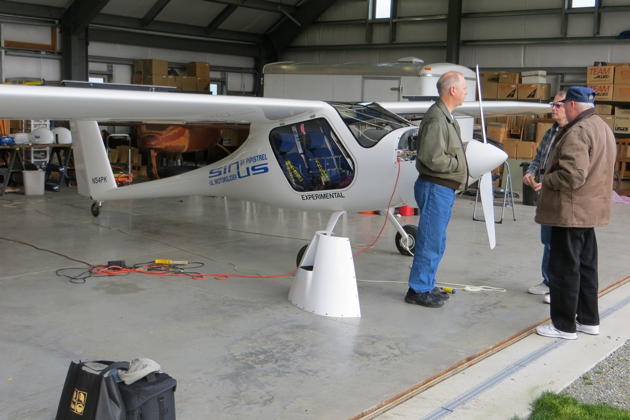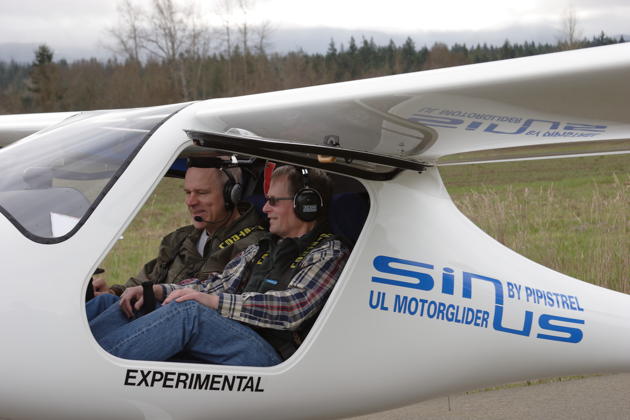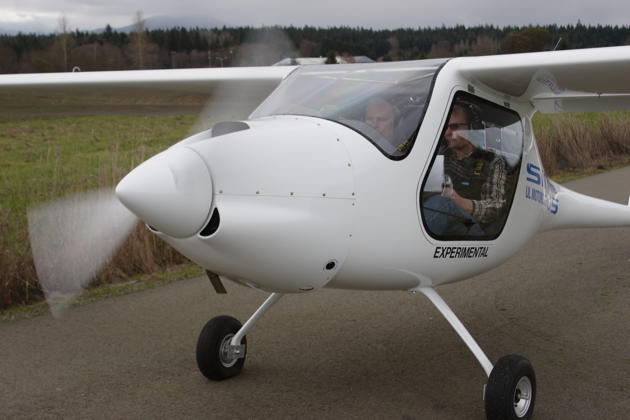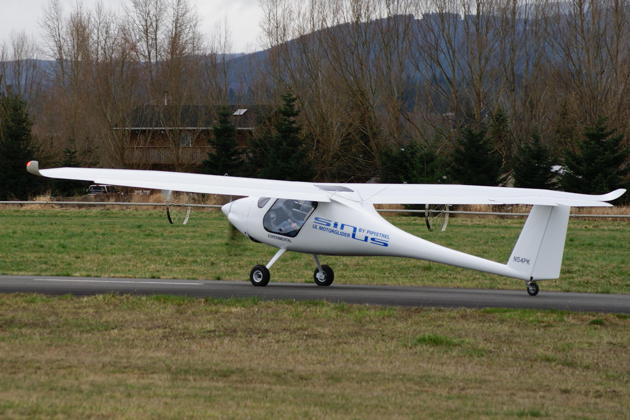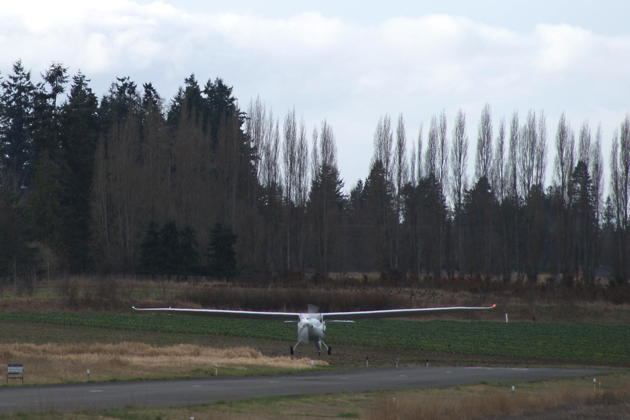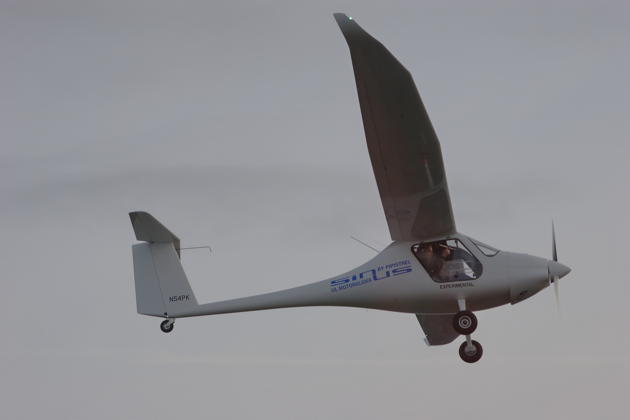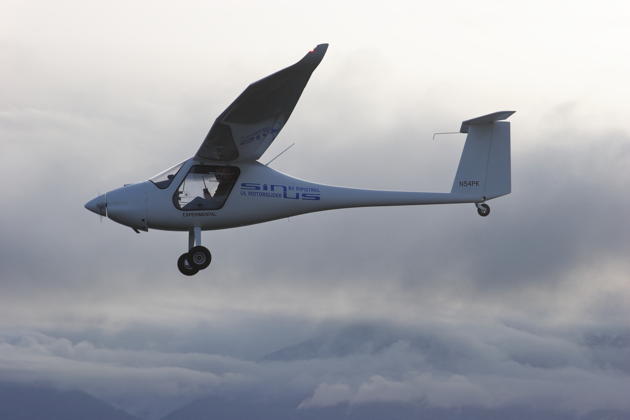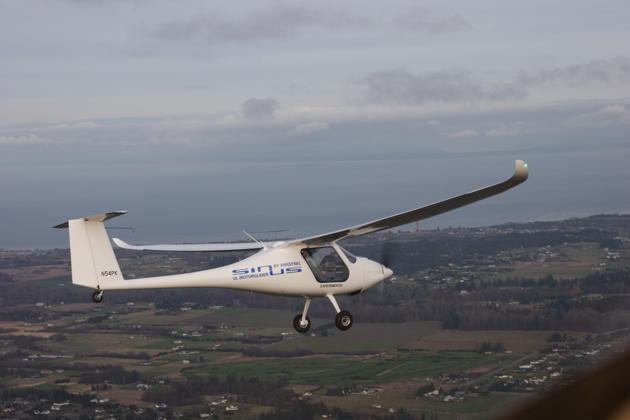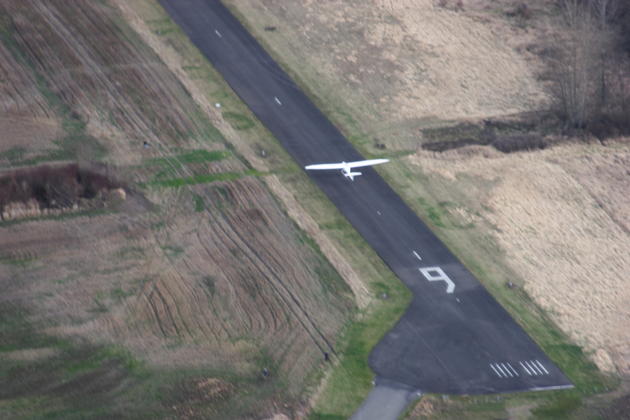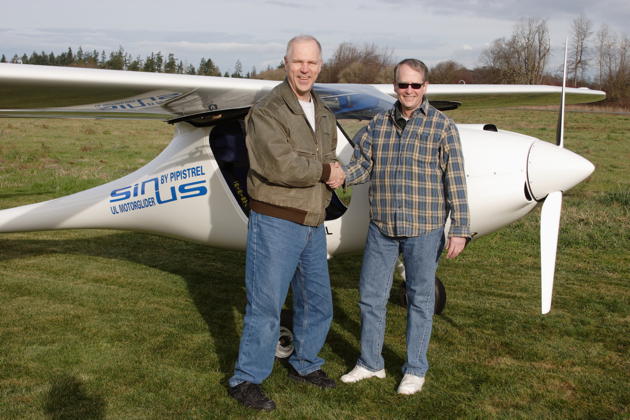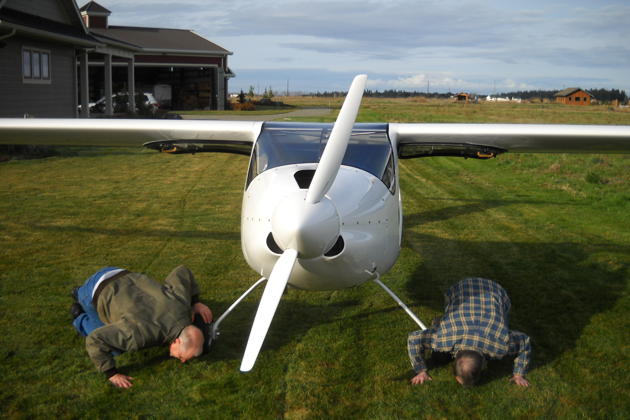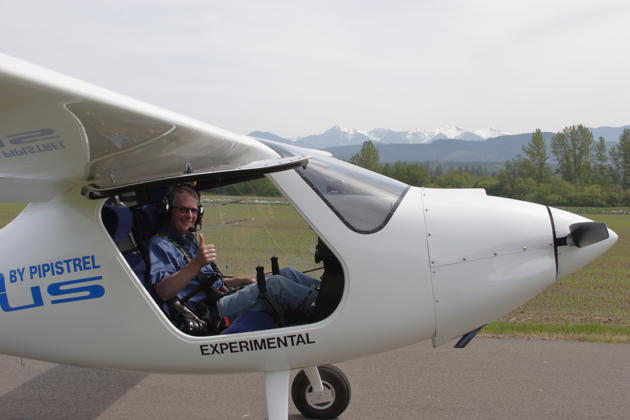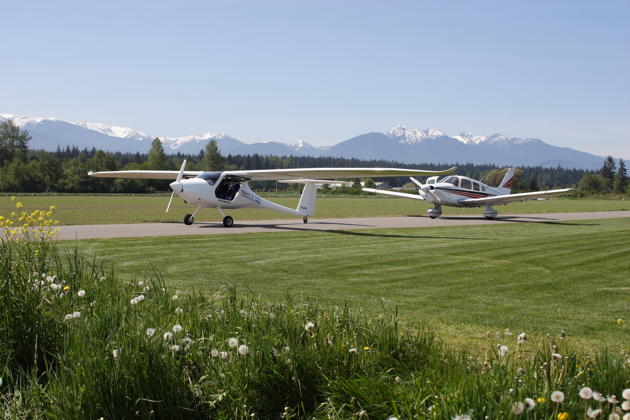FlightLog Archive
∟Aircraft Flown
First Flight in Sinus N54PK - Feb 2013
Paul Kuntz had been building a kit of the Pipistrel Sinus since late 2006. The Pipistrel Sinus is a new motorglider that merges a well-designed sailplane wing with a Rotax powerplant for an impressive aircraft with a combination of good soaring capability along with very efficient cross country touring performance. As he progressed through the aircraft buildup, Paul provided exquisite details of the construction progress on his Sinus website. In 2012, as the project was nearing completion, Paul and I began discussing first flight and checkout plans.
We decided that experience in the same aircraft type would be invaluable for first flights in his personal Sinus. Paul was able to make contact with George Powers, builder of the first Pipistrel Sinus kit to fly in the US, and George offered both of us some flight time in his Sinus. In late September 2012, Paul and I flew to Reno, NV, and had a great weekend checking out in George's Sinus at the Nervino airport in nearby Beckwourth, CA. During 5 enjoyable flight hours, I was able to get a good feel for the airplane, and also provide instruction and a sign-off for Paul in the Sinus.
After our enjoyable Sinus flights and checkouts in September, Paul had only a few cleanup items on his bird to get it ready for FAA inspection and experimental certification. Once the Sinus was ready, the biggest problem Paul encountered was getting the FAA DAR (Designated Airworthiness Representative) to be available, since he was out of the country much of December and January. Finally, on 19 January 2013, Paul's inspection was completed and the Sinus received its airworthiness certificate, with no faults.
I had built up a number of ground and flight test cards, and Paul and I were only waiting on the typically poor Northwest winter weather to improve enough to allow us to fly. After a few false starts and cancellations due to weather, on 17 February 2013 the weather forecast looked decent enough for an attempt. Paul had organized some local pilots to provide ground observers and a chase aircraft, so we all gathered at Paul's home/hangar, which is located on a taxiway adjacent to the Sequim Valley airport.
Paul and I conducted a very thorough pre-flight in his hangar, and then we briefed the test flight cards, ground crew and chase aircraft procedures, to ensure everyone involved was familiar and comfortable with the plan. Paul and I pulled the Sinus from his hangar to the nearby taxiway, strapped in, and carefully walked through the pre-flight and startup procedures. The weather earlier in the day had been mostly clear, but a broken layer had appeared around 3000 feet AGL, but the visibility was unlimited, and the winds were light, so it was on to the taxi and flight tests.
I've been impressed with the ease of starting on the Rotax 912 engine series, and Paul's was no different. A simple push of the starter after switching on a single mag, and the engine smoothly came to life. As we waited for the engine oil temperature to rise, we configured the impressive Dynon dual display suite, selecting detailed flight information over the optional detailed map and GPS displays for the first flights. Our test plan called for low- and medium-speed taxi tests before first flight, which gave me a good feel for the steering capability, visibility, rudder and brake pressures required to maneuver safely. While providing for a sufficiently tight turning radius around the taxiways and on the runway, I felt the capability to turn tightly was limited by our inability to get the tailwheel into a castering free rotation mode, but our turn capability was more than sufficient for our initial flights.
After I completed both the low and medium speed taxi tests, which included acceleration to near tailwheel liftoff speed, I gave Paul a chance to complete his own low and medium speed tests. We taxied back to the runway 9 apron area, shut down, and made a thorough visual inspection, with no issues discovered. The only item of interest was the aircraft VHF radio, which had a loud squeal on transmission and poor reception. To ensure communication, we carried a handheld VHF radio as a backup.
Now ready for first flight, I told the RV-12 chase to launch first, and orbit above the Sequim Valley airport. The winds were light and variable, the Sinus was ready, and now it was our turn to get in the air! Paul and I had agreed that I would have the first takeoff and landing, and we would follow the test card for airwork once airborne. I took runway 9, and smoothly added full throttle on the Sinus, and we very quickly accelerated to tail wheel liftoff speed, and with just a slight bit of aft stick pressure, we were airborne! The engine was humming along fine, and I started a climb over the runway, retracting takeoff flaps passing 50 knots, and both Paul and I were pleased at how quickly we climbed away. The flight controls felt very solid, with no dead spots or tendency to induce a pilot oscillation. I raised another notch of flaps, and started an easy left turn to enter our planned racetrack over the Sequim runway, providing for safe gliding distance in case of any adverse engine issues. I began some light maneuvering, 30 degrees max, to evaluate basic handling. The excellent kit design and Paul's workmanship were evident, as the aircraft maintained position well in a hands-off test, with minimal trim inputs needed. After completing two large racetrack flight patterns, I then let Paul, as the designated flight crew member, check out the handling of his Sinus using the flight controls on the left side of the cockpit, with wide grins very evident.
After Paul completed his two racetrack patterns to the north of the runway with no problems, I took over and began flying practice approaches, at altitude, on the 'pattern', or south side of the runway. I wanted to get a good feel for the airplane at approach speeds and in landing flap configuration, and test the effectiveness of the spoilers, which would be my primary glidepath control on final. At altitude, I flew two complete pattern circuits, and got good calibration on pitch attitudes and control response in the landing configuration. Nearing 1000 feet AGL, I retarded the throttle to idle on downwind, and made a fairly wide, controlled approach to runway 9. I had planned to land about 100 feet down the runway, not wanting to land short on the first flight! Glidepath control was excellent using the spoilers, and I was rewarded with a smooth touchdown in a three-point attitude right at 100 feet down the runway for a first flight that went exactly as briefed and planned on the test card. Paul and I gave each other a 'High-5' after clearing the runway, and we taxied back to his home to the waiting ground and chase crew.
Some First Flight notes to Paul:
- Startup is a joy in the Sinus.
- Once initiating a climb and safely clear of the ground, flap position awareness will be important to not overspeed and/or overstress the flaps.
- RPM awareness during full throttle climbs will ensure the RPM stays within normal limits for long engine life.
- The flight control feel and harmony are awesome! She's going to be a great bird for thermaling!
- Your Dynon displays are impressive! However, don't get too mesmerized with the awesome information presentation and forget to look out the window!
- Control forces are light, but be sure to use the trim for longer flights or when trying to set a reference speed.
Overall, the quality of the Pipistrel kit, combined with Paul Kuntz' meticulous building over the years has produced a very impressive, smooth and well-flying aircraft. Having flown a number of aircraft early in their life, Paul's Sinus had the fewest squawks and smoothest flight controls and handling of almost any aircraft I've flown early in its life. Now it's time to expand the flight envelope and increase Paul's currency and comfort while flying this beautiful airplane.
Epilog
Paul had many long cross-country flights in his Sinus, including five trips to and from Air Venture in Oshkosh. Paul's 2019 Oshkosh trip was described in Kitplanes.
Epilog 2
Paul Kuntz unfortunately placed his Sinus for sale in June 2020, due to deteriorating health after being diagnosed with ALS/Lou Gehrig's disease. Paul sadly passed away on 10 Sep 2020 from complications due to ALS. I helped his family sell his Pipistrel Sinus to a group of local pilots in the Sequim area, and checked out another USAF Academy grad as the lead instructor for the new Sinus group. Paul's bird is flying well, based at nearly Port Angeles (KCLM).
 KASPRZYK
KASPRZYK